Related Research Articles
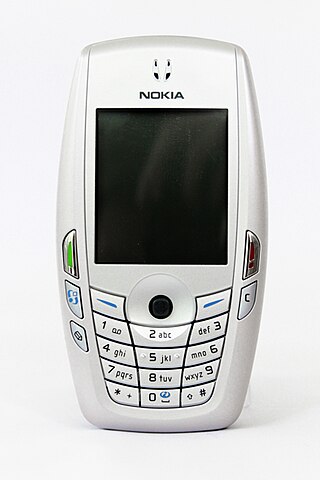
The 6620 is a mobile phone created by Nokia, announced in 2005, running on Series 60 2nd Edition and the Symbian operating system. It was the first EDGE-capable phone for the Americas' market.
The Motorola ROKR, the first version of which was informally known as the iTunes phone, was a series of mobile phones from Motorola, part of a 4LTR line developed before the spin out of Motorola Mobility. ROKR models were released starting in September 2005 and ending in 2011, because of the dissolution of Motorola Inc.. They were notable for incorporating support of media player features.
The Nokia 6000 series or Classic Business series is range of mobile phones marketed by Nokia. This family of phones is notable for their conservative, unisex designs, making them popular with business users.
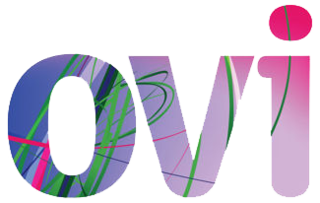
Ovi was the brand for Nokia's Internet services from 2007 to 2012. It was designed to be an umbrella brand as Nokia attempted to expand into software and Internet services instead of just mobile hardware. Ovi focused on five key service areas offered by Nokia: Games, Maps, Media, Messaging and Music.

Nokia 5300 XpressMusic is a slider mobile phone by Nokia, part of the XpressMusic range. It was introduced on 31 August 2006 and released at the end of that year. It runs on Nokia Series 40 3rd Edition FP2.
The Nokia 3600 slide is a mobile phone by Nokia that was released in August 2008. The phone runs the Series 40 3rd Edition platform. This is classed as the 'low end version' of the Nokia 6600 slide, its major difference being the lack of 3G support.
The Nokia 6301 is a triband GSM mobile phone approved by the FCC for the US market in January 2008. It has two major models; the 6301b RM-323 for the North American market and the 6301 RM-322 for the European market. Model 6301b is equipped with 850/1800/1900 MHz bands and model 6301 is equipped with 900/1800/1900 MHz bands.
The LG Incite is an Internet-enabled Windows Mobile Pocket PC smartphone designed and marketed by LG of Korea.

The Nokia 3720 classic is a mobile phone by Nokia announced in July 2009 and manufactured in Hungary. The phone runs the Series 40 6th edition platform.
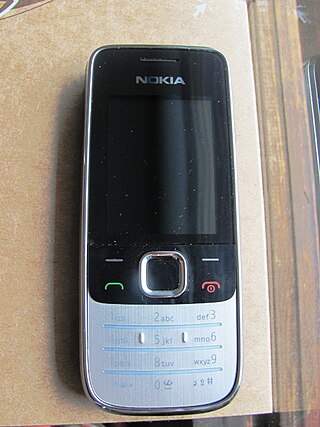
The Nokia 2730 classic is a Nokia Quad-band GSM/UMTS 3G cell phone that includes a camera, FM radio, Bluetooth, music and video player, as well as several internet-based applications.

The Nokia N8 is a touchscreen-based smartphone developed by Nokia. Announced on 27 April 2010, the Nokia N8 was the first device to run on the Symbian^3 mobile operating system and it was the company's flagship device for the year. It was released on 30 September 2010 at the Nokia Online Store before being released in markets around the world on 1 October 2010. There were two versions made, the N8 and the N8-00. The N8 was made for Vodafone and locked to its networks, and the N8-00 was made by Microsoft and open network.
Nokia's strategic nomenclature can be traced back in 2005 when the Nseries line was launched, offering devices with flagship specifications and premium hardware at various price points. These devices were considered the "bread and butter" of the company and were often positioned to showcase their latest technologies. Thanks to the newfound consumer and enterprise interest in smartphones at the time, the company introduced four additional collections to diversify their product portfolio and meet demands in most market segments. These new phone series were named Eseries, targeting small business and enterprise customers; Xseries, providing consumer-grade multimedia-focused devices; Cseries, which Nokia used to target both the low-end and mid-range market segments; and Tseries, for devices exclusive to the Chinese market.
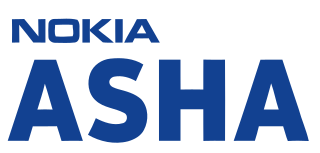
The Nokia Asha 303 is a QWERTY messenger smartphone powered by Nokia's Series 40 operating system. It was announced at Nokia World 2011 in London along with three others Asha phones - the Nokia Asha 200, 201 and 300. The 303 is considered to be the flagship of the Asha family. Its main features are the QWERTY keyboard and capacitive touchscreen, the pentaband 3G radio, SIP VoIP over 3G and Wi-Fi and the ability to play Angry Birds which were all never seen before on a Series 40 phone. Nokia Asha 303 is available in a number of languages depending on which territory it is marketed for. Models sold in South Asia support at least eight languages: English, Hindi, Gujarati, Marathi, Tamil, Kannada, Telugu and Malayalam.

The Nokia Asha 302 is a QWERTY messenger feature phone powered by Nokia's Series 40 operating system. It was announced at Mobile World Congress 2012 in Barcelona along with other Asha phones - the Nokia Asha 202 and 203. The 302 is considered to be among the flagship of the Asha family. Its main features are the QWERTY keyboard, the pentaband 3G radio, SIP VoIP over 3G and Wi-Fi. Its design looks a lot like the older Nokia E6 with chrome slidings, giving it a somewhat premium look. A software update adds Mail for Exchange support.
Microsoft mobile services are a set of proprietary mobile services created specifically for mobile devices; they are typically offered through mobile applications and mobile browser for Windows Phone platforms, BREW, and Java. Microsoft's mobile services are typically connected with a Microsoft account and often come preinstalled on Microsoft's own mobile operating systems while they are offered via various means for other platforms. Microsoft started to develop for mobile computing platforms with the launch of Windows CE in 1996 and later added Microsoft's Pocket Office suite to their Handheld PC line of PDAs in April 2000. From December 2014 to June 2015, Microsoft made a number of corporate acquisitions, buying several of the top applications listed in Google Play and the App Store including Acompli, Sunrise Calendar, Datazen, Wunderlist, Echo Notification Lockscreen, and MileIQ.

The Nokia X2 is an entry-level smartphone which was announced and released by Microsoft Mobile on 24 June 2014. It is the successor of the Nokia X, being the first smartphone running version 2.0 of the Android-based Nokia X platform operating system. The Nokia X family of Android phones was discontinued on July 17, 2014.
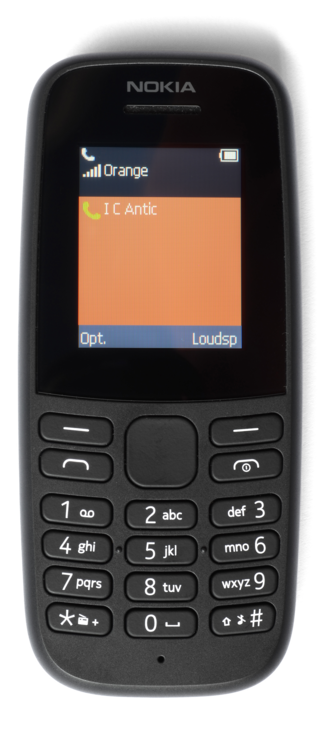
Series 30+ is a software platform and application user interface used for Nokia-branded, then HMD-branded mobile devices since 2024. The platform was introduced by Nokia in September 2013, first appearing on the Nokia 108, and has been the main Nokia feature phone operating system after the end of the Series 30 and Series 40 platforms in 2014. Despite the similar name and user interface, the S30+ is technically completely different and unrelated to the S30.

Nokia C1-02 is a basic phone running on Nokia OS Series 40, announced in June 2010 and released in January 2011. It supports two battery types, Nokia BL-5C and BL-5CB. It has an internal memory of 10 MB and RAM of 16 MB. The expandable memory of the device is up to 32 GB. It is available in four colours namely - Black, Dark Plum, Blue and Cool Grey. Its cost in July 2015 was around Rs. 2169 in India. Outside India it was sold at $19.99 approx.
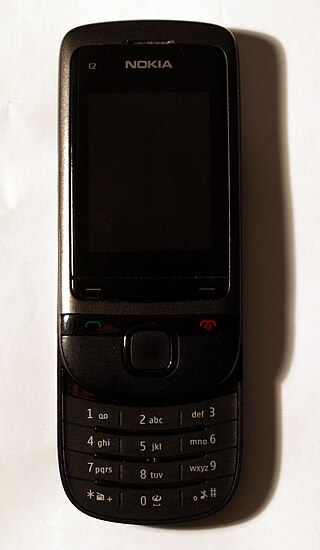
Nokia C2-05 is a sliding model device running on Nokia's Series 40 mobile operating system. It was released in December 2011. It was also the last Nokia phone with sliding keypad ever released and the last in the Nokia Cseries line. The screen of the device is of 2.0 inches TFT with resolution of 240×320 pixels. Its battery BL-4C is of 860 mAh. The device is Bluetooth v2.1 enabled with A2DP and EDR. As of 2015 July, its cost in India is about Rs. 3340. Outside India it is sold for a cost of $74.22 approx.

The Nokia X2-00 is the first low budget phone in the Xseries line from Nokia. This single SIM phone was announced in April 2010 and released in July 2010. It runs on Nokia Series 40 operating system and comes with many pre-installed games and also supports messaging and data connections.
References
- 1 2 3 4 5 "Nokia X2-05". Nokia Europe. 2012. Archived from the original on 2012-04-19.
- 1 2 Delaney, Ian (2011-10-11). "Launch: Nokia C2-05 and Nokia X2-05 – looks and power, for less". Nokia Conversations. Lumia Conversations (Microsoft). Archived from the original on 2015-07-23. Retrieved 2015-07-23.